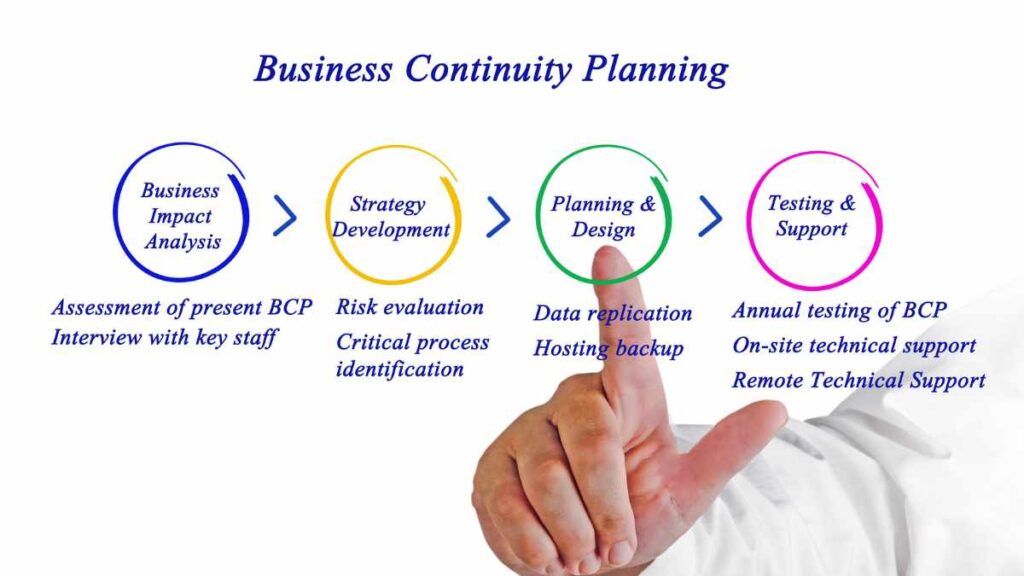Do you know the meaning of Business Continuity Planning? If not, then read this full article.
A business continuity plan aims to ensure that operations continue in the face of potential threats, disruptions, and issues. It is a document that allows for both threat prevention and recovery. The Business Continuity Plan outlines the company’s fundamental operations, points out the systems and processes that must be maintained, and provides instructions on how to do so. The businesses are vulnerable to various hazards, from minor to devastating. Various issues may arise, including pandemics like COVID-19, natural disasters, cyberattacks, human errors, utility outages, etc.
A crisis or issue could impact the organisation’s reputation, the likelihood of competitors gaining an edge, and supply chain disruption. A firm cannot completely focus on insurance claims to pay all costs, such as the cost of clients the company lost to rivals. Therefore there will be a loss of earnings.
Here is an illustration of the Business Continuity Plan: If a lightning strike causes the office building to fire, the company’s primary business is hosting client servers. The office’s entire infrastructure is destroyed by fire, but the clients never notice a difference in the quality of the job. You know why, don’t you? Yes, because of the proper usage of BCP, the company’s top executives moved the office to a temporary site and kept a backup of all client servers. Consider how much confidence and self-assurance you could gain if you could manage your weaknesses and turn them into strengths.
A business that builds a Business Continuity Plan achieves a similar result. BCPs are distinct from disaster recovery plans, which are concerned with restoring an organisation’s IT infrastructure following a catastrophe. IT professionals establish the BCP, but executives and managers also contribute to discussing the various organisational functions.
A Business Continuity Plan is required to be reviewed again and again. It needs to be comprehensive ( try to list all possible disruptions and lots of backup plans), adaptable (plenty of flexibility and adjustability), efficient (makes it function properly), and realistic (possible in the problematic situation). The standard for continuing planning serves as a foundation for BCP; there are international standards called ISO for business continuity followed by other standards. Furthermore, some recommended questions for the preparation of BCP by Susan Snedaker in the book Business Continuity and Disaster Recovery Planning for IT professionals are whether the business organisation can operate without computers, laptops, servers, email, and internet access and how? What is the company doing to manage risk?
What are the vital functions of outsourcing? What are the alternatives that can be used instead of crucial internal operations? What are the essential abilities, information, and know-how required for recovery? What must roles be performed in the event of a disaster by the employees?
What are The Steps For Creating a Business Continuity Plan?

Determine The Aims of Your Business Continuity Plan
The business continuity plan of an organisation encompasses all types of business-critical services, including finance, sales, marketing, public relations, human resources, and more, in addition to the disaster recovery plan, which is only applicable to the IT department. The plan’s goal and the organisation’s goal must be complementary. To ensure that the least amount of damage is done and to benefit from the preparation of BCP, the aims of the plans must be determined.
Create a Team Ready For Any Urgency and Disaster
A team must be prepared for any emergency or tragedy. Since the organisation’s destiny is in its hands, the team members must be experts in handling the problems. The team is in charge of developing and carrying out all business continuity plans. To prevent any issues, make sure there are multiple leaders. To make BCP successful, the team must operate successfully and efficiently.
Run a Business Impact Analysis as Well as a Risk Assessment
A risk appraisal is crucial because a corporation must understand its risk before proceeding. An efficient risk appraisal is crucial to minimise any chance of a company disruption. Risk assessment and analysis can be done in a variety of ways. Businesses must develop BCP based on the kind and nature of risks.
Analyse What the Crucial Business Operations Are
To create alternatives for how your company will run in the event of risks, you must first identify the operations for which they must be found. Examples include maintaining customer service standards, order completion and shipping timeframes, stock control and distribution consistency, and e-commerce network performance. The business continuity plan must also consider the many departments, such as marketing, human resources, etc.
Make a Business Continuity Plan For Each of The Above Crucial Business Operations
Create a backup plan in case something goes wrong. Plan techniques like backup and recovery, DRaaS, redundancy, etc., to ensure your company offers its customers high-quality goods and services and that there is the least disturbance to sales, productivity, data, etc. The plan must include everything one needs in the event of a contingency.
Double-check If all The Risks Have Been Taken Into Consideration
Verify the business continuity plan to see if all potential hazards have been considered. The strategy must be adaptable to accommodate any necessary adjustments. Making a plan in this way will reduce the potential for interruption while enabling the business to operate effectively. Always have a documented emergency policy in place, as well as information on your level of business risk, your available financial resources in the event of a disaster, how to communicate with your staff in an emergency, and other community partners that may assist you in a time of need.
Staff Training, Testing, Revisions, and Plan Updates

To make sure the business continuity plan will function in an emergency, it must be given to the stakeholders who will test it. If the work needs to be changed, they will provide guidelines. Additionally, it’s important to teach the staff management skills and job duties. The strategy must be flexible. Thus it must be regularly reviewed and modified to account for environmental changes.
Conclusion
An organisation must establish a Business Continuity Plan to ensure its survival in the event of attacks, disruptions, etc. It aids the company in maintaining its profitability, reputation, supply chain, and capacity to outperform rivals. A business continuity plan needs to be thorough, effective, flexible, and realistic. Figure out the objectives of the business continuity plan, organise a team to respond to any catastrophic events, conduct a business impact analysis and evaluation, outline the important business operations, devise a plan for each of the aforementioned key business operations, and implement the plan. Verify again to see if all potential dangers have been considered. Updates to the plan, testing, adjustments, and staff training.
For more insights and ideas related to businesses, marketing, social media, financial awareness, business essentials and technology check out BiznessHub, to explore further opportunities and knowledge.
FAQs
Ques. What is a Business Continuity Plan?
Ans. A business Continuity Plan outlines how the business should be operated when something unexpected occurs.
Ques. What are the benefits of a Business Continuity Planning?
Ans. Strategy, Organization, Processes, Technology, Facilities, etc.
Ques. Is Business Continuity Planning important?
Ans. Yes, it aids in recovering from drastic situations.




